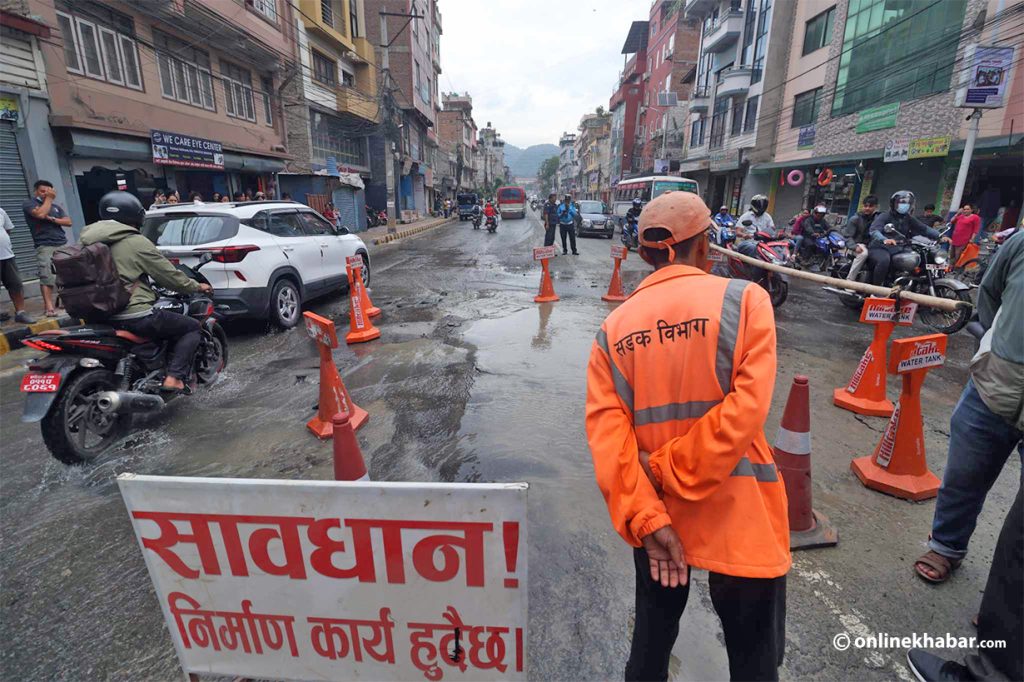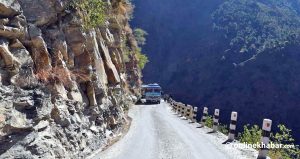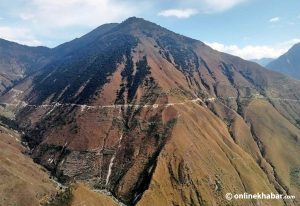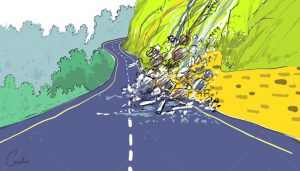
Words of folk singer Milan Lama’s song Jhalko Lali Othako used to resonate in the villages of Karnali around 2005. With the first car that arrived in Karnali, the song too started playing there and hooked people. And, it was not just music to the Karnali people but also their history, life stories and experiences.
After 2006, with the start of the peace accord, Karnali Highway opened for public transportation. The end of a 10-year armed conflict and vehicles in the backyard was a great achievement for the people there. And, as the song’s lyrics aptly said, “Their feet were not on the ground” (because they were so happy).
However, their happiness did not last long. Contrary to their expectations, only the number of accidents and damage started to increase on Karnali Highway, drawing the whole of Karnali into grief during the festivals. So far, the road has recorded more than 1,000 deaths and 1,000 injuries. And with the numbers, this highway, once the threshold of development, got a new name: the highway of death.
Highway to death

Karnali Highway is killing many prematurely, every year. Accidents happen elsewhere too, but if an independent study of the accidents on this highway is to be done, it would be evident that many people lost their lives because of the poor infrastructure. However, no one has shown interest in such a study.
On March 18, 2010, a passenger bus (Na 3 Kha 5868) of Kankrevihar Transport was en route to Surkhet from Kalikot when it hit a rock at Kitu Bhir in Dailekh and fell into the Karnali river. As many as 41 people lost their lives in that accident. It was a terrible moment for the country.
Another gut-wrenching incident occurred on October 14, 2011, during the Dashain festival, when 33 people lost their lives after a bus (Bhe 1 Kha 3167) crashed. It was carrying students who were returning home for the Dashain holidays and fell into the Pinatpane river in Chhayanath Rara-7, Mugu.
Two months after that, 28 people lost their lives when a bus crashed in Serabada Bittamod, Kalikot. Many people lost their lives in other accidents that occurred in the same year. It included 13 deaths in Gadgadeni of Jumla, 14 in Khidki of Dailekh and 15 in Kalyankadha of Surkhet. Similarly, on March 16, 2015, a bus accident in Raralihi of Jumla killed 18 people including an infant. The bus fell into the Tila river 200 meters off the road.
According to the traffic police, the causes of these deaths on Karnali Highway were the same: narrow roads, a lack of necessary road safety signs and overcrowded vehicles. Not only in public transport even cargo trucks also are not empty. Driver Ganesh BK says, “It is difficult to pass a vehicle in a narrow and difficult place. If a vehicle comes from the other side, you have to back up.”
These are just some of the major accidents on Karnali Highway, but even with these few, one can paint a picture of the road conditions in Karnali.
Fatal data

Along Karnali Highway, there are many narrow turns in various road sections in the Dailekh and Kalikot districts. According to SSP Madhav Shrestha, the spokesperson of the Karnali Province Traffic Police Office, Surkhet, accidents on the highway are increasing due to narrow and difficult roads, passengers more than capacity, old vehicles and disregard for traffic rules as well as a lack of public awareness about road safety.
He adds, “The geography of Karnali is also difficult while the road is in a dilapidated state, so it is a challenge to prevent accidents.”
According to the data from the Karnali Province Traffic Police Office, there occurred 1,821 road accidents in Karnali alone in the last nine fiscal years. The death toll in these accidents is 991 while 1,527 people got seriously injured. The social, human and physical damage of these accidents is not even accounted for.
It also shows that human casualties are more in the Karnali region than in other places. “If only rescue operations are done timely we can save lives. However, due to the geographical structure, immediate rescue is not possible in Karnali and almost 100 per cent of the passengers die when there is a vehicle accident,” laments Shrestha.
And the number is only rising. However, no one has shown interest in mitigation. Leela Bahadur Bhandari, the former head of the road division office in Jumla, says that Karnali Highway should have been two-lane.
Shrestha says the main reasons for the accident are the difficult geography, unsafe roads and human error. These days Hiace and other small vehicles are getting more into accidents. He adds, “Poor road safety and negligence of drivers who drive long routes and also at high speeds and haphazard overtake attempts are all adding to the risks of accidents on Karnali Highway.”

According to engineer Top Narayan Poudel, information officer of the Road Division Office, Surkhet, many accidents have happened on dirt roads, which also see more landslides. Landslides always occur on the highway due to weak rocks and steep ground. He says, “Some maintenance has been going on, but it is not enough to prevent landslides; some places must be reconstructed. But that needs a sufficient budget, which is lacking.”
“Apart from this, violation of traffic rules, driving under the influence, unruly overtaking and using mobile phones while driving have also caused accidents,” says Shrestha. “The driver needs to pay more attention to the road and consider the vehicle’s condition along with the road’s condition to minimise the accidents.”
Luck in the driving seat
Travelling on Karnali Highway and coming out alive has become a matter of luck for the citizens here. Anyone who travels Karnali roads needs to be daredevil. Karnali has hilly terrain and narrow one-lane roads.
“We look at the Karnali river on the sides and the dry landslides on the verge of falling from above, and all we can do is pray for survival. It is no less than a miracle,” says Bhautik Malla of Jajarkot, who returned from Rara after celebrating the New Year.
And since there is no space for maintenance, the passengers do not just board the vehicle but become the ones who push or carry the vehicle to reach their destination. He adds, “When it rains, the road becomes muddy and when the sun shines, it is dusty. We have to always trust god while travelling.”
Shahi, who runs a shop on the side of the highway, says, “We have to keep going to Surkhet via Karnali Highway to bring the goods for the shop. And every time it is like getting a new life when we reach home safely.”
Journalist Anka Lal Budha of Mugu says that the highway, the road leading to Rara, one of the main tourist spots in Karnali, has been neglected for a long time already. “Many tourists who visit Rara vow not to return just because of the road,” he adds.
No interest in the repair
Prime Minister Girija Prasad Koirala in 1991 laid the foundation stone for the construction of Karnali Highway. But only after 15 years of struggle with the armed conflict and lack of budget, it was completed. And given the labour-intensive job of opening the track by removing rocks and boulders, the Nepali Army was mobilised.
Funded with the financial support of the World Bank, the government had blacktopped 126 km from Surkhet to Khidkijyula in Dailekh and 107 km from Khidkijeula to Jumla. The highway connects Karnali through Surkhet, Dailekh, Kalikot and Jumla along the banks of Karnali river and Mugu.
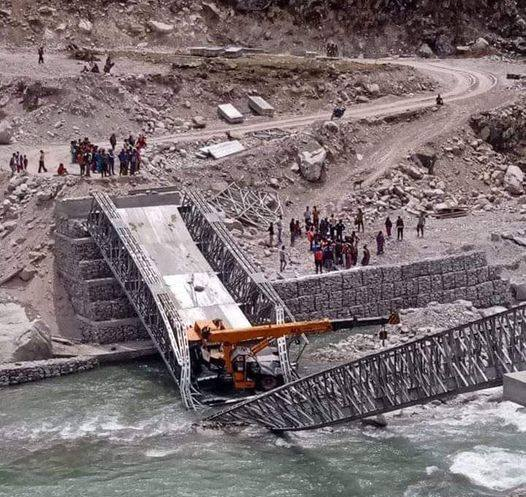
The 232-km Karnali Highway is not a highway in terms of quality and convenience, it is just a track hastily dug in the mountains. In just five years, about 95 per cent of the road was destroyed. The federal government has not been able to maintain the road for the minimum level of operation, let alone the necessary construction or maintenance. There are not even basic road signs along this road.
It has been 17 years since the track opened, but it is far away from Singhadarbar’s sight for any upgrade or reconstruction.
Navaraj Koirala of Kalikot, who was also a member of the first Constituent Assembly, thinks that the government has forgotten Karnali is a part of this country and that is killing the citizens on Karnali Highway that does not even meet the minimum engineering standards.
Koirala recalls that Jagdish Chandra Pokharel, a member of the then National Planning Commission, who reached Jumla on April 13, 2007, to inaugurate the highway was afraid to travel to Kathmandu so he returned on a helicopter.
Despite the first-hand experience and his repeated requests put forward to include Karnali Highway in the national pride projects, Koirala says Pokharel was not interested to adhere to the requests. Koirala has many more examples of such discriminatory behaviour towards Karnali.
“The political parties of Jumla, Mugu and Kalikot and their cadres and leaders chant their slogans for the repairing and maintaining of the highway every election. However, after winning, they all ignore it,” says Shahi adding that Karnali’s development will be incomplete until the highway is repaired.
Province’s failure
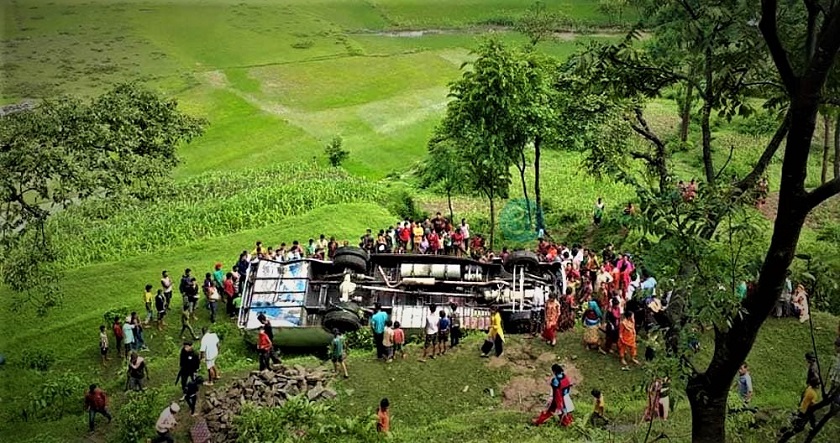
The Karnali provincial government introduced a road safety programme in early 2018. Its main purpose was to reduce traffic accidents on Karnali highway and other roads. This programme, initiated by the Ministry of Internal Affairs and Law, was initiated by the then chief minister Mahendra Bahadur Shahi.
Under the programme, plans included adding GPS to buses plying Karnali Highway (232 km), Chhinchu-Jajarkot Road (107 km), Surkhet-Dailekh headquarters (65 km) and Kapurkot-Rukum road sections, along with police patrolling. But, like other programmes, this one also could not be implemented.
Shahi instead gave priority to the construction of expressways to expand the road network with China. The federal government under KP Sharma Oli also shifted its priority. Ultimately, the Chinese government also poured its interest and furthered its Belt and Road Initiative, as per the agreement between Nepal and China. The neighbours also conducted a feasibility study and preliminary survey to build a 530 km road network connecting Hilsa near the Chinese border and Yamuna near the Indian border area.
Shahi had been claiming that this road is of strategic importance and would be the lifeline for the Karnali people. But, as per the constitution, the provincial government could not enter into any agreements with other countries and was expecting the federal government to lend its assistance for the project. However, Shahi says that the plan could not go ahead as the then federal government did not show much interest.
This story was translated from the original Nepali version and edited for clarity and length.






